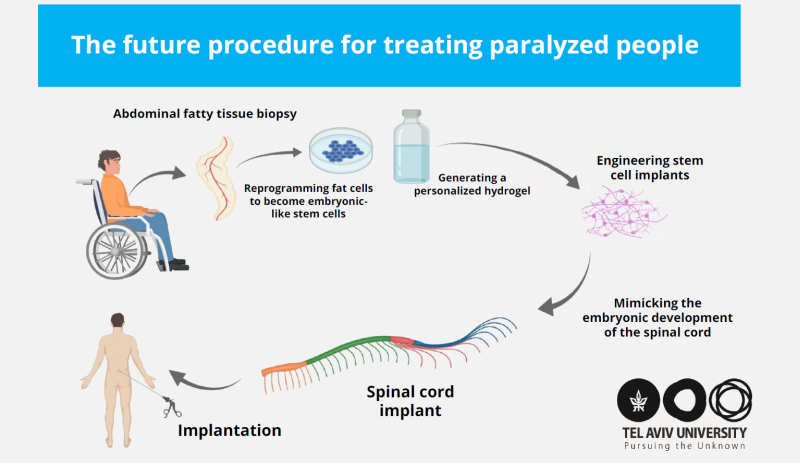For the first time ever, researchers at Tel Aviv University’s Sagol Center for Regenerative Biotechnology created technology that within a few years paralyzed people may be able to walk again.
The technology behind the breakthrough uses 3D human tissue samples, transforming it into a functioning spinal cord implant via a process that mimics the development of the spinal cord in human embryos. The results were extremely encouraging: nearly 80% of patients regained walking ability. The researchers are now planning for the study’s next stage: clinical trials with humans. They anticipate that within a few years, the modified tissues will be put into paralyzed persons, restoring their ability to stand and walk.
The study’s findings were published in the highly regarded scientific journal Advanced Science.
Will you offer us a hand? Every gift, regardless of size, fuels our future.
Your critical contribution enables us to maintain our independence from shareholders or wealthy owners, allowing us to keep up reporting without bias. It means we can continue to make Jewish Business News available to everyone.
You can support us for as little as $1 via PayPal at office@jewishbusinessnews.com.
Thank you.
Professor Tal Dvir the lead researcher explains, “Our technology is based on taking a small biopsy of belly fat tissue from the patient. This tissue, like all tissues in our body, consists of cells together with an extracellular matrix (comprising substances like collagens and sugars).
‘After separating the cells from the extracellular matrix we used genetic engineering to reprogram the cells, reverting them to a state that resembles embryonic stem cells – namely cells capable of becoming any type of cell in the body.
‘From the extracellular matrix, we produced a personalized hydrogel, that would evoke no immune response or rejection after implantation. We then encapsulated the stem cells in the hydrogel and in a process that mimics the embryonic development of the spinal cord we turned the cells into 3D implants of neuronal networks containing motor neurons.”
The human spinal cord implants were subsequently inserted into lab models divided into two groups: those who had been paralyzed lately (the acute model) and those who had been paralyzed for an extended period of time – around a year in human terms (the chronic model). Following implantation, 100% of lab models with acute paralysis and 80% of those with persistent paralysis were able to walk again.
Prof. Dvir: “The model animals experienced a speedy rehabilitation procedure and were able to walk quite well at the conclusion. This is the first time that implanted modified human tissues have been shown to restore function in an animal model of long-term chronic paralysis – the most important model for human paralysis therapy.
“There are millions of people worldwide who are paralyzed as a result of spinal damage, and there is currently no viable treatment available. Individuals who are paralyzed at an early age are doomed to spend the remainder of their life in a wheelchair, facing all the social, economical, and health-related consequences associated with paralysis. Our objective is to develop individualized spinal cord implants for each paralyzed individual, allowing for the regeneration of injured tissue without risk of rejection.”
In 2019, Prof. Dvir founded Matricelf (matricelf.com) with industry partners, based on the innovative organ engineering technique pioneered in his lab. The company follows Prof. Dvir’s lead in pursuing the goal of commercializing spinal cord implant treatments for paralyzed individuals.
Prof. Dvir, says, “We want to advance to human clinical trials in the next few years and eventually get these patients back on their feet.”
The FDA has already discussed the company’s preclinical program. “Given that we are presenting a cutting-edge regenerative medicine technology and that there is now no viable option for paralyzed individuals, we have reason to anticipate very speedy approval of our technology,” according to Prof. Dvir.





